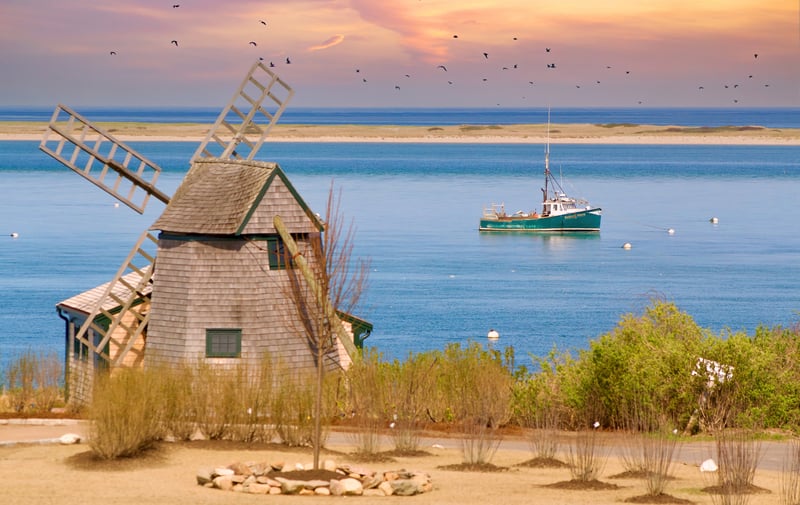History Of Cape Cod: From Fishing And Whaling To Tourist Destination
 By
Luke Chapman
·
4 minute read
By
Luke Chapman
·
4 minute read

Discover the captivating journey of Cape Cod, transforming from a humble fishing and whaling hub to a bustling tourist haven.
Early Beginnings: Native Tribes and European Exploration
Cape Cod's history begins with the Native American tribes, notably the Wampanoag, who lived harmoniously with the land long before European settlers arrived. The Wampanoag people, whose name means "People of the First Light," were adept at utilizing the natural resources around them. They thrived on fishing, farming, and hunting, establishing a deep connection with the coastal environment. Their diet included fish, shellfish, corn, beans, and squash, which they cultivated using sophisticated agricultural techniques. The Wampanoag also built wetuash, dome-shaped homes made from wooden frames covered with woven mats and bark, which were well-suited to the region's climate. Their social structure was complex, with a strong emphasis on community and kinship, and they held seasonal celebrations and ceremonies that honored their connection to the land and sea.
European exploration began in the early 17th century, with notable explorers like Bartholomew Gosnold and Samuel de Champlain mapping the region. Gosnold, in 1602, named Cape Cod for the abundance of codfish in its waters, while Champlain's detailed maps and accounts provided valuable insights into the geography and native populations. The arrival of the Pilgrims in 1620 marked a significant turning point, leading to the establishment of settlements and the gradual displacement of the native tribes. The Pilgrims, seeking religious freedom, landed at what is now Provincetown before moving on to establish Plymouth Colony. Their arrival brought profound changes, including the introduction of European agricultural practices, new forms of governance, and unfortunately, diseases to which the Native Americans had no immunity. This led to a dramatic decline in the native population and the eventual loss of their traditional lands and way of life. The early interactions between the Pilgrims and the Wampanoag, including the famous Thanksgiving feast, were complex and fraught with both cooperation and conflict, setting the stage for the future development of Cape Cod.
The Rise of Fishing and Whaling Industries

By the 18th century, Cape Cod had become a bustling hub for fishing and whaling. The rich waters of the Atlantic provided abundant resources, making fishing a primary economic activity. Fishermen harvested a variety of fish, including cod, haddock, and mackerel, which were then salted and shipped to markets both domestically and internationally. The whaling industry also flourished, with the Cape’s ports becoming pivotal in the global trade of whale oil. Whaling ships embarked on long voyages, often lasting several years, to hunt whales in distant oceans. The oil extracted from whale blubber was highly sought after for its use in lamps, soaps, and lubricants, making it a valuable commodity.
These industries not only shaped the economy but also the social fabric of Cape Cod. Fishing villages sprang up along the coast, characterized by their quaint, weathered cottages and bustling docks. The culture of hard work and maritime expertise became deeply ingrained in the local communities. Families often worked together, with men heading out to sea while women and children processed the catch and maintained the household. The maritime lifestyle fostered a strong sense of camaraderie and resilience among the residents, who relied on each other for support in the face of the often harsh and unpredictable ocean. This period also saw the development of shipbuilding and related trades, further embedding the maritime heritage into the identity of Cape Cod.
Economic Shifts: Decline of Maritime Industries
The mid-19th century saw a gradual decline in the fishing and whaling industries. Overfishing depleted the once-abundant fish stocks, making it increasingly difficult for fishermen to sustain their livelihoods. Simultaneously, advancements in maritime technologies, such as the development of steam-powered vessels, began to outpace the traditional sailing ships used by Cape Cod's fishermen and whalers. The discovery of petroleum further compounded these challenges by providing a cheaper and more efficient alternative to whale oil, which had been a cornerstone of the local economy. These factors collectively reduced the demand for whale oil and fish, leading to significant economic shifts in the region.
Despite the decline, the resilient Cape Cod community demonstrated remarkable adaptability by turning to other economic activities. Cranberry farming emerged as a viable alternative, capitalizing on the region's unique bogs and wetlands. Farmers developed innovative techniques for cultivating and harvesting cranberries, eventually making Cape Cod one of the leading producers of this tart fruit. Salt production also became an important industry, with the area's coastal location providing ideal conditions for evaporating seawater to extract salt. These new ventures not only provided alternative sources of income but also marked a significant transformation in the region's economic landscape. This shift set the stage for future developments, paving the way for Cape Cod to evolve and thrive in the face of changing economic conditions.
The Birth of Tourism: Beaches, Shopping, and Dining
.jpg)
As the maritime industries declined, Cape Cod began to develop as a tourist destination in the late 19th and early 20th centuries. The region's natural beauty, characterized by its beaches and charming villages, attracted visitors from across the nation. The coastal landscapes, with their rolling dunes and sparkling waters, offered a peaceful retreat from urban life. The area also drew artists and writers, who were inspired by its tranquil scenery and unique light, leading to the creation of several artist colonies. These creative communities contributed to Cape Cod's appeal, adding a cultural dimension to its natural attractions.
Investment in infrastructure, such as the creation of the Cape Cod Canal, further boosted tourism. The canal, completed in 1914, not only facilitated maritime navigation but also made the region more accessible to tourists. Improved transportation links, including the expansion of railroads and the development of highways, allowed more people to visit Cape Cod with ease. Over time, the region developed a reputation for its pristine beaches, unique shopping experiences, and diverse dining options, transforming into a beloved vacation spot. The establishment of charming bed-and-breakfasts, luxurious resorts, and a variety of recreational activities, such as sailing, fishing, and golfing, catered to the growing number of visitors. Seasonal events and festivals celebrating local traditions and crafts also became a staple, drawing crowds and fostering a sense of community. This evolution marked Cape Cod's transition from a maritime hub to a premier tourist destination, renowned for its blend of natural beauty, cultural richness, and hospitality.
Modern Cape Cod: Balancing Heritage and Tourism
Today, Cape Cod is a thriving tourist destination, welcoming millions of visitors each year. The region offers a blend of historical sites, cultural attractions, and modern amenities, catering to a wide range of interests. Visitors can explore the rich history of the area through its numerous museums, historic homes, and lighthouses, each telling a unique story of the Cape's past. Cultural attractions abound, from art galleries and theaters showcasing local talent to music festivals and craft fairs that celebrate the region's artistic heritage. Modern amenities, including upscale resorts, gourmet restaurants, and boutique shops, provide a luxurious experience for those seeking relaxation and indulgence. Outdoor enthusiasts can enjoy a variety of activities such as hiking, biking, and kayaking, taking in the stunning natural landscapes that Cape Cod is renowned for.
However, Cape Cod also faces the challenge of balancing its rich heritage with the demands of tourism. Efforts are ongoing to preserve the natural environment and historical landmarks while providing an exceptional experience for visitors. Local organizations and government agencies work tirelessly to protect the delicate ecosystems, ensuring that the beaches, dunes, and marshlands remain pristine. Historic preservation initiatives aim to maintain the integrity of the region's architectural treasures, allowing future generations to appreciate the Cape's storied past. Community engagement plays a crucial role, with residents and businesses collaborating to promote sustainable tourism practices. This delicate balance ensures that Cape Cod remains a cherished destination for future generations, where the charm of its history and the vibrancy of its present coexist harmoniously.









